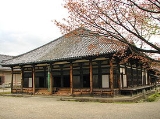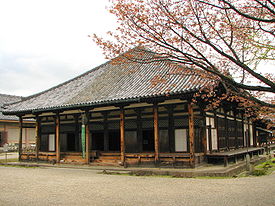
Gango-ji
Encyclopedia


Temple
A temple is a structure reserved for religious or spiritual activities, such as prayer and sacrifice, or analogous rites. A templum constituted a sacred precinct as defined by a priest, or augur. It has the same root as the word "template," a plan in preparation of the building that was marked out...
, that was once one of the powerful Nanto Shichi Daiji
Nanto Shichi Daiji
Nanto Shichi Daiji , literally "the seven great temples of Nanto " is a historical common name generally referring to the powerful and influential seven Buddhist temples located in Nara...
, in Nara
Nara, Nara
is the capital city of Nara Prefecture in the Kansai region of Japan. The city occupies the northern part of Nara Prefecture, directly bordering Kyoto Prefecture...
, Japan
Japan
Japan is an island nation in East Asia. Located in the Pacific Ocean, it lies to the east of the Sea of Japan, China, North Korea, South Korea and Russia, stretching from the Sea of Okhotsk in the north to the East China Sea and Taiwan in the south...
.
History
The original foundation of the temple was by Soga no UmakoSoga no Umako
was the son of Soga no Iname and a member of the powerful Soga clan of Japan.Umako conducted political reforms with Prince Shōtoku during the rules of Emperor Bidatsu and Empress Suiko and established the Soga clan's stronghold in the government by having his daughter married with members of the...
in Asuka
Asuka, Yamato
was one of the Imperial capitals of Japan during the Asuka period , which takes its name from this place. It is located in the present-day village of Asuka, Nara Prefecture....
, as Asuka-dera
Asuka-dera
', also known as ', is a Buddhist temple in Asuka, Nara. Asuka-dera is regarded as one of the oldest in Japan.-Temple complex:A number of records refer to the origin of the temple, such as the Nihongi and Fusō-ryakuki...
. The temple was moved to Nara in 718, following the capital relocation to Heijō-kyō
Heijo Palace
' in Nara, was the Imperial Palace of Japan , during most of the Nara period. The Palace was located in the north end of the capital city, Heijō-kyō...
.
Gangō-ji initially held as much as seven halls and pagodas on its complex ground, which occupied a wide area within what is now Naramachi, the preserved district of modern Nara city. The original architecture were, however, lost over time and notably in fires during the 15th and 19th centuries (Muromachi and Edo period respectively).
Architecture


World Heritage Site
A UNESCO World Heritage Site is a place that is listed by the UNESCO as of special cultural or physical significance...
"Historic Monuments of Ancient Nara
Historic Monuments of Ancient Nara
The UNESCO World Heritage Site Historic Monuments of Ancient Nara encompasses eight places in the old capital Nara in Nara Prefecture, Japan. Five are Buddhist temples, one is a Shinto shrine, one is a Palace and one a primeval forest. The properties include 26 buildings designated by the Japanese...
", and holds three national treasures
National treasures of Japan
National Treasures are the most precious of Japan's Tangible Cultural Properties, as determined and designated by the Agency for Cultural Affairs...
:
- the HondōHondo-Places:*Rio Hondo, the name of several locations*Hondo, Texas, a city in the United States*Hondo, New Mexico*Hondo, Kumamoto, a city in Kumamoto Prefecture, Japan: old name for the main Japanese island of Honshū-Fiction:...
(本堂, the main hall), or the Gokurakubō (極楽坊), which is one of the few well-preserved structure of the temple, - the ZenZenZen is a school of Mahāyāna Buddhism founded by the Buddhist monk Bodhidharma. The word Zen is from the Japanese pronunciation of the Chinese word Chán , which in turn is derived from the Sanskrit word dhyāna, which can be approximately translated as "meditation" or "meditative state."Zen...
room - the miniature (5.5 meters tall) five-story pagoda
Most of the destroyed complex ground has altered and melted itself into parts of Naramachi over the course. Another small part of the temple remains today as the other Gangō-ji, of a
Kegon
Kegon
Kegon is the name of the Japanese transmission of the Huayan school of Chinese Buddhism.Huayan studies were founded in Japan when, in 736, the scholar-priest Rōben originally a monk of the Hossō tradition invited Shinshō to give lectures on the Avatamsaka Sutra at...
school but with little remainders in terms of architecture.
Gangō-ji in the Man'yōshū
The Man'yōshū includes a poem attributed to a monk of Gango-ji. This poet laments that, having attained enlightenment, his greater understanding remains unnoticed by others in the streets of Nara. His poem may perhaps bemoan his undervalued condition -- and yet, in a modest way, his words transport contemporary readers momentarily back to share his quiet, 8th century perspective:-
-
- A White gem unknown of men --
- Be it so if no one knows!
- Since I myself know its worth
- Although no other --
- Be it so if no one knows!
- -- A monk of the Gango-ji Temple
-
See also
- Asuka-deraAsuka-dera', also known as ', is a Buddhist temple in Asuka, Nara. Asuka-dera is regarded as one of the oldest in Japan.-Temple complex:A number of records refer to the origin of the temple, such as the Nihongi and Fusō-ryakuki...
- Gangōji Garan EngiGangoji Garan Engi, often abbreviated to Gangōji Garan Engi, is a Japanese Buddhist text. It is one volume in length and was compiled by an unnamed Buddhist monk in 747.-Contents:...
, a historical text of the temple - List of National Treasures of Japan (temples)
- List of National Treasures of Japan (sculptures)
- For an explanation of terms concerning Japanese Buddhism, Japanese Buddhist art, and Japanese Buddhist temple architecture, see the Glossary of Japanese BuddhismGlossary of Japanese BuddhismThis is the glossary of Japanese Buddhism, including major terms the casual reader might find useful in understanding articles on the subject. Words followed by an asterisk are illustrated by an image in one of the photo galleries...
.

